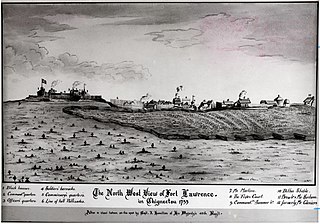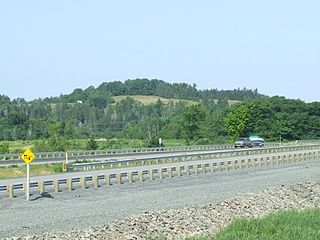Related Research Articles

The Acadians are the descendants of the French who settled in Acadia during the 17th and 18th centuries.

The Expulsion of the Acadians, also known as the Great Upheaval, the Great Expulsion, the Great Deportation, and the Deportation of the Acadians, was the forced removal by the British of the Acadian people from the present-day Canadian Maritime provinces of Nova Scotia, New Brunswick, and Prince Edward Island, and the present-day U.S. state of Maine — parts of an area historically known as Acadia, causing the deaths of thousands of people. The Expulsion (1755–1764) occurred during the French and Indian War and was part of the British military campaign against New France. The British first deported Acadians to the Thirteen Colonies, and after 1758, transported additional Acadians to Britain and France. In all, of the 14,100 Acadians in the region, approximately 11,500 were deported, of which at least 5,000 died of disease, starvation or in shipwrecks. Men, women and children were forcibly removed from their homes and their land, which they'd farmed for a century. Their houses were burned and their land given to settlers loyal to Britain, mostly immigrants from New England and then Scotland. The event is largely regarded as a crime against humanity, though contemporary use of the term genocide is debated by scholars. A census of 1764 indicates that 2,600 Acadians remained in the colony having eluded capture.

Port-Royal National Historic Site is a National Historic Site located on the north bank of the Annapolis Basin in the community of Port Royal, Nova Scotia, Canada. The site is the location of the Habitation at Port-Royal.

Brigadier-General Charles Lawrence was a British military officer who, as lieutenant governor and subsequently governor of Nova Scotia, is perhaps best known for overseeing the Expulsion of the Acadians and settling the New England Planters in Nova Scotia. He was born in Plymouth, England, and died in Halifax, Nova Scotia. According to historian Elizabeth Griffiths, Lawrence was seen as a "competent", "efficient" officer with a "service record that had earned him fairly rapid promotion, a person of considerable administrative talent who was trusted by both Cornwallis and Hopson." He is buried in the crypt of St. Paul's Church (Halifax).

Fort Lawrence was a British fort built during Father Le Loutre's War and located on the Isthmus of Chignecto.

West Lawrencetown is a residential community within the Halifax Regional Municipality Nova Scotia on the Eastern Shore on Route 207 along the scenic route Marine Drive.

Lawrencetown is a Canadian rural community in the Halifax Regional Municipality in Nova Scotia, Canada. The settlement was established during the eve of Father Le Loutre's War and at the beginning of the French and Indian War.
Jean Baudoin (1662–1698) was a French Sulpician priest who served as a missionary in Acadia, and later as a chaplain during military expeditions carried on by Pierre Le Moyne d'Iberville.
Emmanuel Le Borgne de Belle-Isle was the governor of Acadia in 1657–67 and was the claimant to the estate of Charles de Menou d'Aulnay who had governed Acadia until his death.
Clerbaud Bergier was a Huguenot trader and an early figure in the economic development of Acadia.

The siege of Port Royal, also known as the Conquest of Acadia, was a military siege conducted by British regular and provincial forces under the command of Francis Nicholson against a French Acadian garrison and the Wabanaki Confederacy under the command of Daniel d'Auger de Subercase, at the Acadian capital, Port Royal. The successful British siege marked the beginning of permanent British control over the peninsular portion of Acadia, which they renamed Nova Scotia, and it was the first time the British took and held a French colonial possession. After the French surrender, the British occupied the fort in the capital with all the pomp and ceremony of having captured one of the great fortresses of Europe, and renamed it Annapolis Royal.

The Battle at St. Croix was fought during Father Le Loutre's War between Gorham's Rangers and Mi'kmaq at Battle Hill in the community of St. Croix, Nova Scotia. The battle lasted from March 20–23, 1750.
This is a bibliography of major works on Nova Scotia.

The siege of Grand Pré happened during Father Le Loutre's War and was fought between the British and the Wabanaki Confederacy and Acadian militia. The siege happened at Fort Vieux Logis, Grand-Pré. The native and Acadia militia laid siege to Fort Vieux Logis for a week in November 1749. One historian states that the intent of the siege was to help facilitate the Acadian Exodus from the region.

Fort Vieux Logis was a small British frontier fort built at present-day Hortonville, Nova Scotia, Canada in 1749, during Father Le Loutre's War (1749). Ranger John Gorham moved a blockhouse he erected in Annapolis Royal in 1744 to the site of Vieux Logis. The fort was in use until 1754. The British rebuilt the fort again during the French and Indian War and named it Fort Montague (1760).

The Battle at Chignecto happened during Father Le Loutre's War when Charles Lawrence, in command of the 45th Regiment of Foot and the 47th Regiment, John Gorham in command of the Rangers and Captain John Rous in command of the navy, fought against the French monarchists at Chignecto. This battle was the first attempt by the British to occupy the head of the Bay of Fundy since the disastrous Battle of Grand Pré three years earlier. They fought against a militia made up of Mi'kmaq and Acadians led by Jean-Louis Le Loutre and Joseph Broussard (Beausoliel). The battle happened at Isthmus of Chignecto, Nova Scotia on 3 September 1750.

This is a bibliography of works on the Provinces and territories of Canada.
The Northeast Coast campaign (1723) occurred during Father Rale's War from April 19, 1723 – January 28, 1724. In response to the previous year, in which New England attacked the Wabanaki Confederacy at Norridgewock and Penobscot, the Wabanaki Confederacy retaliated by attacking the coast of present-day Maine that was below the Kennebec River, the border of Acadia. They attacked English settlements on the coast of present-day Maine between Berwick and Mount Desert Island. Casco was the principal settlement. The 1723 campaign was so successful along the Maine frontier that Dummer ordered its evacuation to the blockhouses in the spring of 1724.

The Siege of Annapolis Royal in 1745 involved the third of four attempts by the French, along with their Acadian and native allies, to regain the capital of Nova Scotia/Acadia, Annapolis Royal, during King George's War. During the siege William Pote was taken prisoner and wrote one of the rare captivity narratives that exist from Nova Scotia and Acadia.

The Acadian Civil War (1635–1654) was fought between competing governors of the French province of Acadia. Governor Charles de Saint-Étienne de la Tour had been granted one area of territory by King Louis XIV, and Charles de Menou d'Aulnay had been granted another area. The divisions made by the king were geographically uninformed, and the two territories and their administrative centres overlapped. The conflict was intensified by personal animosity between the two governors, and came to an end when d'Aulnay successfully expelled la Tour from his holdings. D'Aulnay's success was effectively overturned after his death when la Tour married D'Aulnay's widow in 1653.
References
- ↑ John Grenier. Edge of Empire: War in Nova Scotia. 2008. p. 6
- ↑ "Lorimer Academic - Naomi E. S. Griffiths". Academic.lorimer.ca. Retrieved 2013-07-29.